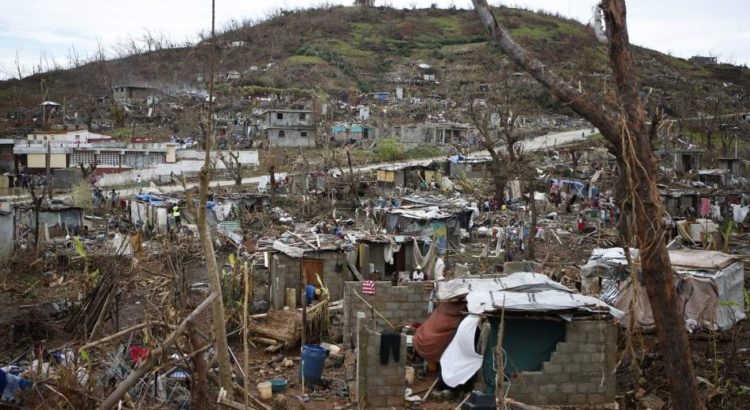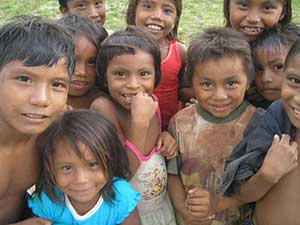Centroamérica/Haiti/Noviembre de 2016/Fuente: 20 minutos
Fuente: http://www.20minutos.es/noticia/2880433/0/haiti-matthew-vive-situacion-critica-mes-despues-paso-huracan/

Centroamérica/Haiti/Noviembre de 2016/Fuente: 20 minutos
Fuente: http://www.20minutos.es/noticia/2880433/0/haiti-matthew-vive-situacion-critica-mes-despues-paso-huracan/

América del Norte/Estados Unidos/Octubre de 2016/Autor: Leslie Boid/Fuente: Mountainx
RESUMEN: La pobreza infantil no es simplemente de los pequeños que son incapaces de tener la última moda o gadget; la pobreza es el trauma que induce, Mims dice, y que afecta a más de uno de cada cuatro niños en Carolina del Norte. En algunos condados, más de uno de cada tres niños vive en la pobreza.En la búsqueda de soluciones, Pisgah Legal Services patrocinó su sexto foro anual de la pobreza, el 5 de octubre, con un discurso de apertura por el reconocido defensor de los niños Marian Wright Edelman, fundadora y presidente del Fondo para la Defensa de los Niños. Estados Unidos ocupa el puesto 34 de 35 países industrializados cuando se trata de la pobreza infantil, Edelman dice, con más de uno de cada cinco niños que viven por debajo del nivel federal de pobreza. Sólo Rumania ocupa el menor. En Carolina del Norte, un nuevo informe del Centro de Presupuesto y de Impuestos del Centro de Justicia de Carolina del Norte muestra que la pobreza está en un nivel superior – más del 16 por ciento en general – de lo que era antes de la recesión de 2008. Según reporte de Cuenta de Niños de la Fundación Annie E. Casey, publicado anualmente, en todo el estado de pobreza infantil era de 25,1 por ciento en 2013, el último año del que se dispone de datos.
The little girl needed extensive dental work, says Susan Mims, director of Mission Children’s Hospital. The girl had squirmed in the chair when told she needed to brush her teeth every day and then said she couldn’t.
“We asked her, ‘Why not? What are your barriers?’ and [the girl] told us she had nowhere to spit because she lived in a car,” says Mims.
Child poverty is not simply about little ones being unable to have the latest fashion or gadget; poverty is trauma-inducing, Mims says, and it affects more than one in four children in North Carolina. In some counties, more than one in three children live in poverty.
In the search for solutions, Pisgah Legal Services sponsored its sixth annual poverty forum on Oct. 5, with a keynote address by renowned child advocate Marian Wright Edelman, founder and president of the Children’s Defense Fund.
The United States ranks 34th of 35 industrialized countries when it comes to child poverty, Edelman says, with more than one in five children living below the federal poverty level. Only Romania ranks lower.
In North Carolina, a new report from the N.C. Justice Center’s Budget and Tax Center shows that poverty is at a higher level — more than 16 percent overall — than it was before the 2008 recession. According to the Annie E. Casey Foundation’s Kids Count report, issued annually, child poverty statewide was 25.1 percent in 2013, the last year for which data are available.
According to Kids Count data, Buncombe County’s rate was 22 percent in 2013. Among Western North Carolina counties, Graham County had the highest child poverty rate at 35.9 percent, but Avery, Cherokee, Clay, Haywood, Jackson, Macon, Madison, McDowell, Rutherford, Swain and Yancey counties all had rates above 30 percent.
Nationally, Edelman says, the numbers are 14.5 million children in poverty and 6.5 million living at half the poverty level or below.
The National Center for Children in Poverty places the national number at 15 million, or 21 percent of all children.
The cost of addressing child poverty in the United States — crime, imprisonment, lost work opportunities, illness, etc. — is about $500 billion annually, Edelman says, while the cost of lifting children out of poverty would be about $77 billion.
“If society cares about children, it should spend money on them,” Edelman said during her speech. “We need to create a new Dow Jones … with its stock in children’s lives.”
As researchers have begun to study the results of poverty and its effect on the developing brain, they have found changes in the structure of the brain brought about by the stresses, Mims says, and those stresses have lifelong implications.
People who were raised in poverty have four times the risk of depression and 12 times the risk of suicide, Mims says. They are 2.5 times more likely to develop chronic obstructive pulmonary disease, hepatitis, lung cancer and heart disease.
“We don’t know the exact mechanisms of why this happens, but we know it does,” she says. “We tend to think of trauma as an accident of being beaten up, but this long-term, low-level stress acts the same way [on the brain and body] as trauma.”
The good news, say Mims and Edelman, is that this damage can be mitigated by helping children change their response to stressors. Some schools are replacing detention with meditation, punishment with positive strategies, and that is helping.
More local governments are reacting in creative ways to address the health effects of poverty on children, says Pisgah Legal Services attorney Jackie Kiser, who serves on the advisory board for the Community Health Improvement Process. The group puts together a Community Health Assessment every three years with a list of priorities to be addressed.
The most recent assessment calls for people of all ages to have the opportunity to eat healthy foods, be active and better manage chronic illnesses. It also advocates for children to have safe, stable and nurturing relationships and environments to ensure they reach their full potential.
One barrier to the eradication of child poverty is that American society tends to blame people for their poverty, Edelman says, while refusing to raise the minimum wage to a living wage, failing to fund child care and underfunding education, nutrition programs, housing assistance and other assistance for people in poverty.
“American children in poverty didn’t ask to be born,” she said. “They didn’t choose their parents or their neighborhoods.”
And because of where they live, they attend poorer schools, have fewer safe places to play and are less likely to have a nurturing relationship with a caregiver after school. They get less exercise and have less access to nutritious food because their neighborhoods likely don’t have grocery stores or restaurants that serve healthy food. In addition, their homes are more likely to have mold, lead and other contaminants that make them sick or sicker, says Edelman.
Children in poverty are more likely to attend schools with so-called zero-tolerance policies that criminalize behaviors once handled by school personnel, she continues, so children in poverty are more likely to enter the justice system than those from homes with sufficient incomes.
Libby Kiles, a teacher at Isaac Dickson Elementary School in Asheville, sees the effects of poverty on children every day. “It’s like dealing with PTSD,” she said during a panel discussion after Edelman’s speech. “They’re not in safe places, they witness violence, they don’t get good nutrition, and they don’t get enough sleep.”
And although Asheville and Buncombe County schools are working to address the physical and emotional ramifications of poverty and other traumas, we need to address the problems as a nation, not at school district, city, county or even state levels, said Edelman.
“Children in Massachusetts aren’t more deserving than children in Mississippi,” she said. “I will never understand why any state would refuse Medicaid expansion.”
The best, most practical solution to poverty in America lies with the voters, Edelman said after the program.
“Get to the voting booth,” she said. “Your vote connects right to children. So much is riding on this.”
Fuente: https://mountainx.com/living/childhood-poverty-has-lifelong-ramifications/
Imagen de archivo

África/Subsahariana/Octubre 2016/Noticias/http://www.lainformacion.com/
La pobreza extrema se redujo en el mundo, pero su erradicación está amenazada por el agravamiento de las desigualdades económicas, sostiene un informe del Banco Mundial (BM) publicado este domingo.
En total, 767 millones de personas vivían todavía con menos de 1,90 dólares diarios en 2013, de las que casi la mitad se encontraban en África subsahariana, según los datos más recientes, incluidos en el informe, publicado antes de la asamblea anual del Fondo Monetario Internacional y el Banco Mundial.
En términos interanuales, esta cifra supone una caída del 12% de la extrema pobreza en todo el mundo, a pesar del crecimiento más lento, celebró el BM.
La caída es aún más pronunciada a largo plazo, si se compara con los casi 2.000 millones de personas pobres registradas en 1990.
«No obstante, el número de personas privadas de un ingreso decente sigue siendo demasiado grande», consideró el presidente de la entidad, Jim Yong Kim, en un comunicado.
El Banco Mundial, que aspira a erradicar la pobreza extrema antes de 2030, advierte que este objetivo no se alcanzará si no se abordan las desigualdades económicas.
«No lo lograremos salvo que hagamos que el crecimiento beneficie a los más pobres. Y, para ello, hay que tratar las fuertes desigualdades», apuntó Kim.
Entre 2008 y 2013, los ingresos del 60% de los más ricos aumentaron más deprisa que los del 40% de las personas más pobres en casi la mitad de los 84 países estudiados en el informe
Fuente :
Fuente imagen:
https://lh3.googleusercontent.com/SuW1Dav5GeUG-pkGOS8pL6y_EZEfhsUX69RzuwR0T9JPBcquQstShVvesqUdJ00CwMb-yg=s151